
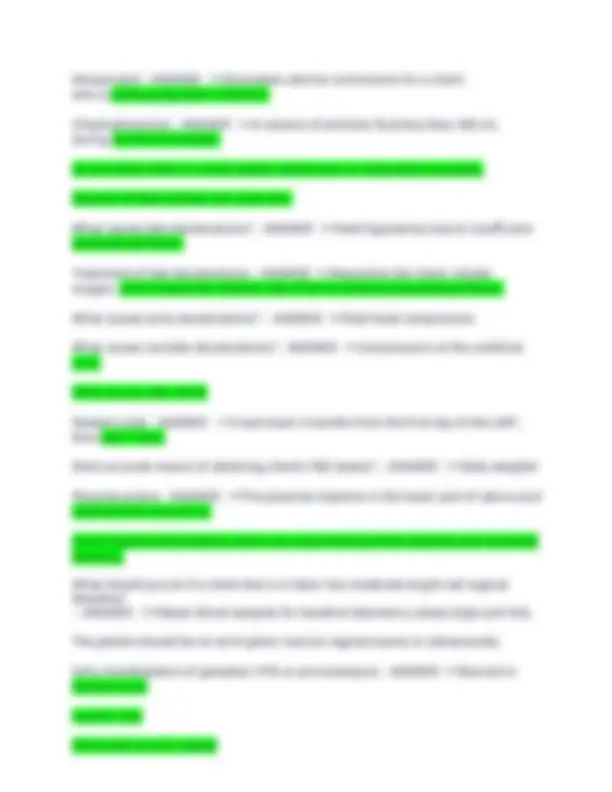
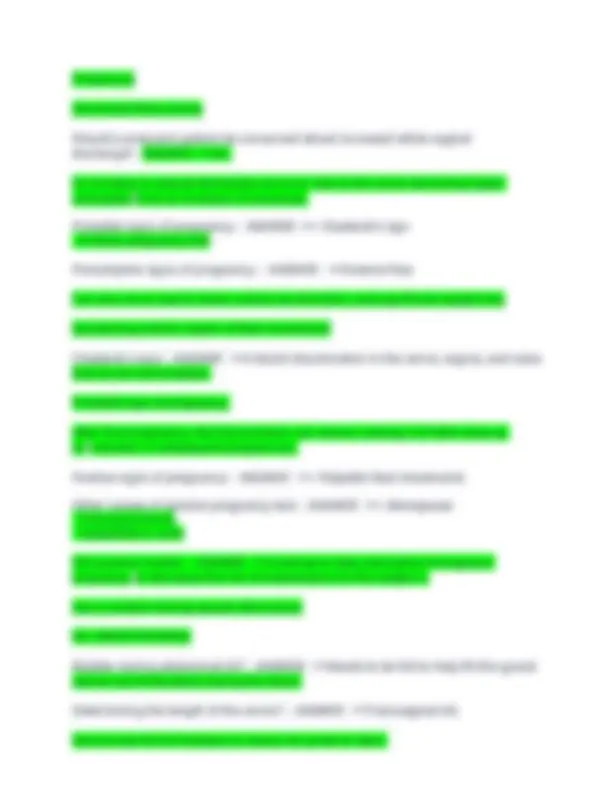
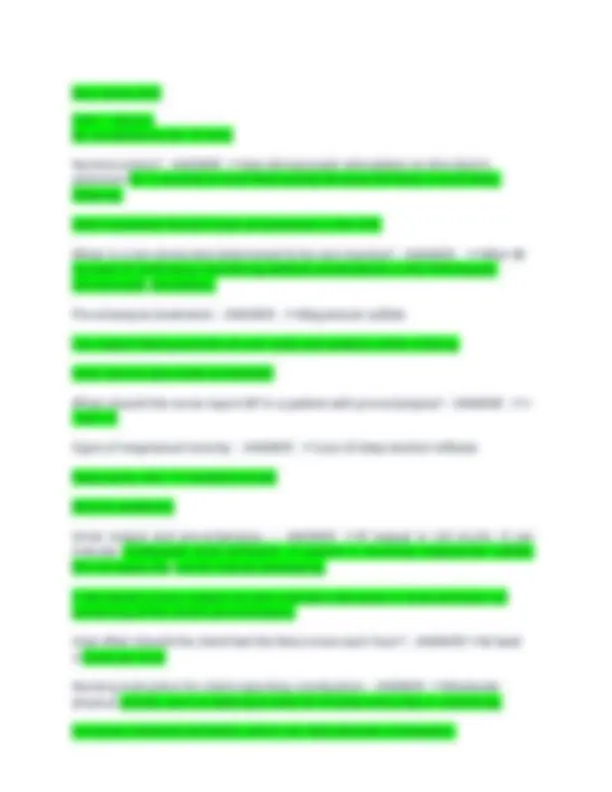

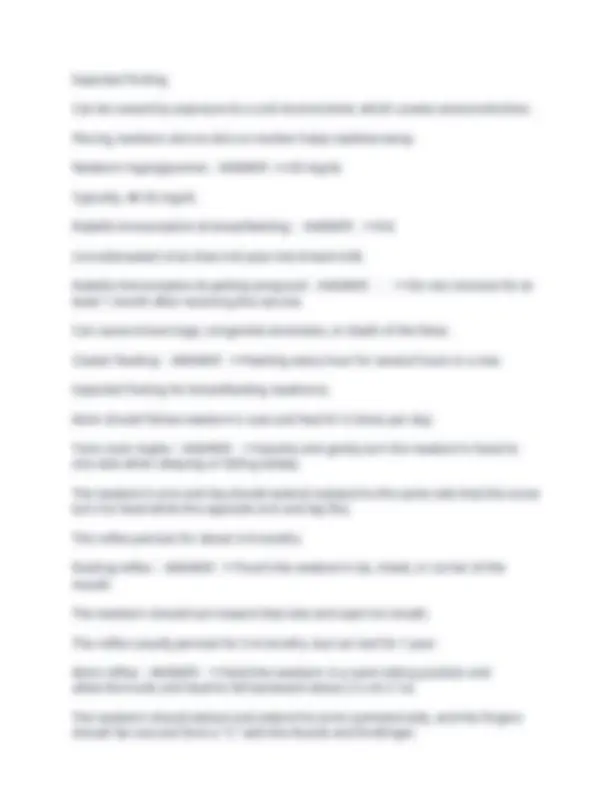
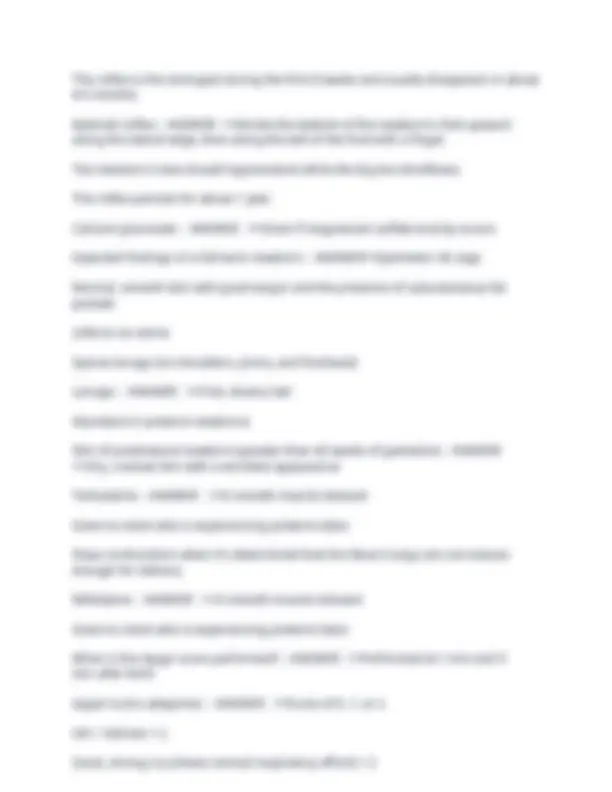

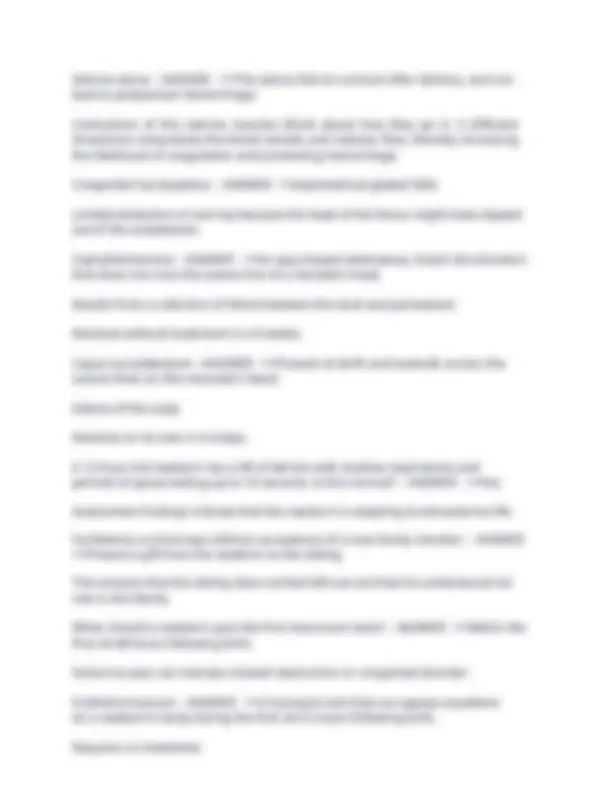
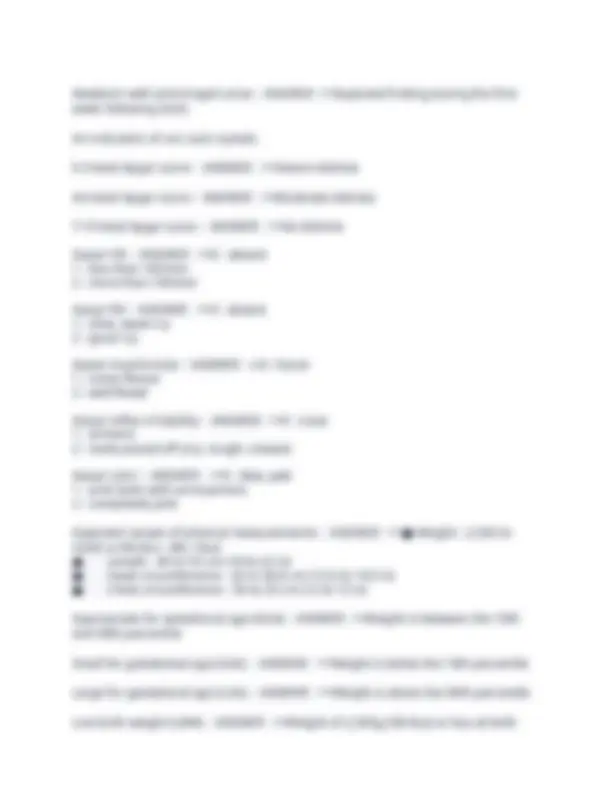
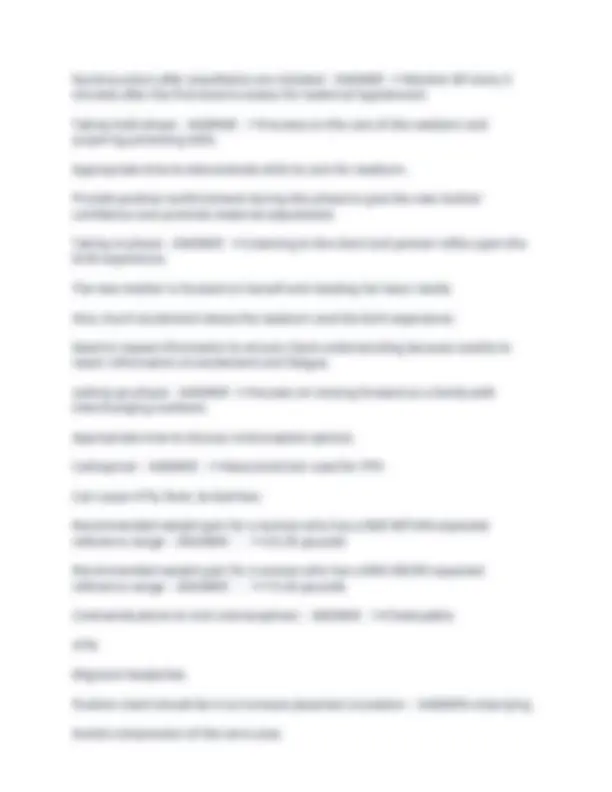
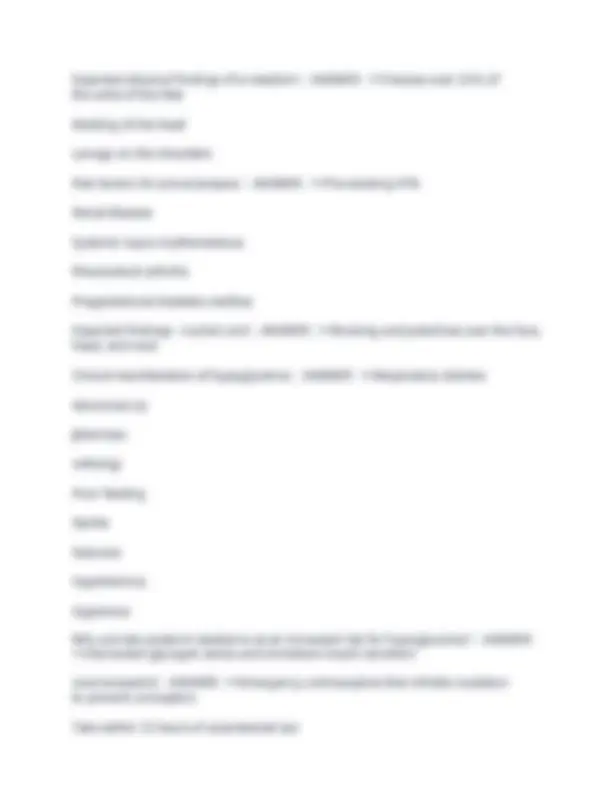
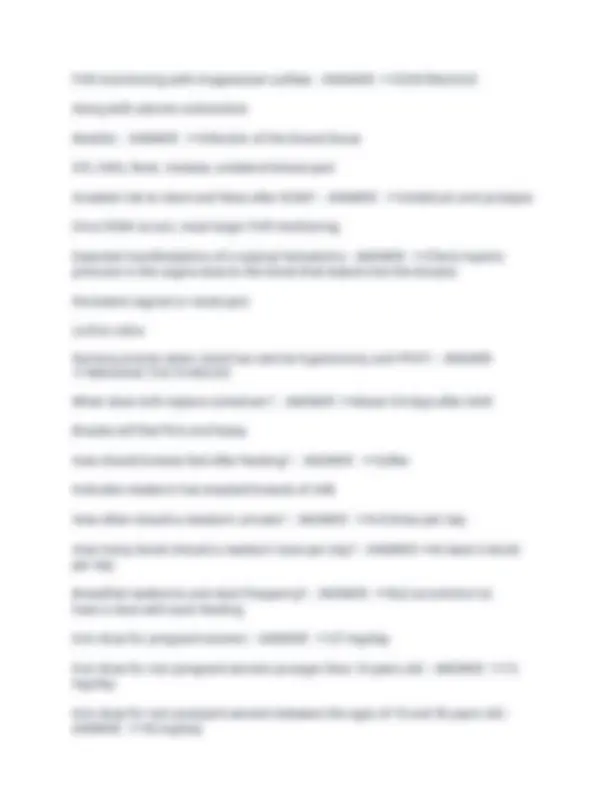



Study with the several resources on Docsity

Earn points by helping other students or get them with a premium plan


Prepare for your exams
Study with the several resources on Docsity

Earn points to download
Earn points by helping other students or get them with a premium plan
Community
Ask the community for help and clear up your study doubts
Discover the best universities in your country according to Docsity users
Free resources
Download our free guides on studying techniques, anxiety management strategies, and thesis advice from Docsity tutors
ATI Capstone Maternal Newborn Assessment questions with answers
Typology: Exams
1 / 21

This page cannot be seen from the preview
Don't miss anything!














What hormone is the basis for pregnancy testing? - ANSWER ==Human chorionic gonadotropin Excreted by the placenta and promotes the excretion of progesterone and estrogen. Uterine fibroid - ANSWER ==Can increase the risk for postpartum hemorrhage due to the increase in blood supply to the uterus, which supports the fibroid. Will undergo serial US examinations during pregnancy to monitor because they are likely to grow during pregnancy in response to the increased circulating estrogen. Can have a vaginal delivery if it is small and not near the cervical os. Hydatidiform mole - ANSWER ==AKA a molar pregnancy. A benign proliferative growth of the chorionic villi, which gives rise to multiple cysts. The products of conception transform into a large number of edematous, fluid- filled vesicles. As cells slough off the uterine wall, vaginal discharge is usually dark brown and can contain grape-like clusters. Alleviating lower back pain during the latent phase of labor - ANSWER ==Counter- pressure applied to the client's sacral area during contractions. This lifts the fetal head away from the sacral nerves, which decreases pain. Preterm labor - which medication should the nurse plan to administer? - ANSWER ==Betamethasone IM A glucocorticoid that stimulates fetal lung maturity and thereby prevents respiratory depression. Methylergonovine - ANSWER ==An ergot alkaloid. For patients experiencing postpartum hemorrhage. Stimulates uterine contractions.
Poractant alfa - ANSWER ==A synthetic lung surfactant. Administer to a preterm newborn who is experiencing respiratory distress.
Proteinuria Decreased fetal activity Should a pregnant patient be concerned about increased white vaginal discharge? - ANSWER ==No. An increase in vaginal discharge can occur due to the cervix becoming hyper- stimulated from an increase in hormones. Probable signs of pregnancy - ANSWER ==- Chadwick's sign
Non-stress test: FHR = 130/min No accelerations for 10 mins Nursing action? - ANSWER ==Use vibroacoustic stimulation on the client's abdomen for 3 seconds to elicit fetal activity because the fetus is most likely sleeping. Fetal movement should cause accelerations in the FHR. When is a non-stress test determined to be non-reactive? - ANSWER ==After 40 minutes of continuous monitoring without accelerations in the FHR despite vibroacoustic stimulation. Pre-eclampsia treatment - ANSWER ==Magnesium sulfate Can expect feeling warmth all over body and sedation while infusing. Have calcium gluconate at bedside!! When should the nurse report BP in a patient with pre-eclampsia? - ANSWER ==> 160/ Signs of magnesium toxicity - ANSWER ==Loss of deep tendon reflexes Respiratory rate <12 breaths/minute Muscle weakness Urine output and pre-eclampsia... - ANSWER ==If output is <20 mL/hr, it can indicate inadequate renal perfusion. If patient is receiving magnesium sulfate, this increases the risk for toxicity developing. A decreased urinary output can also indicate a decrease in renal perfusion s/t worsening of the client's pre-eclampsia. How often should the client feel the fetus move each hour? - ANSWER ==At least 3 times per hour Nursing instruction for client reporting constipation - ANSWER ==Moderate physical activity, such as walking at least 30 minutes every day or swimming. Increases intestinal peristalsis, which can help alleviate constipation.
Oxytocin - client has contractions every 2 minutes that last 100-110 seconds and the FHR is reassuring. Nursing action? - ANSWER ==Decrease the oxytocin by half because the client is experiencing uterine tachysystole. Premature newborn: skin-to-skin - ANSWER ==Decreases stress in the parent and newborn. Promotes newborn development. Helps maintain thermal stability, raises oxygen saturations, increases feeding strength, and promotes breastfeeding. Premature newborn: visual and auditory stimulation - ANSWER ==ADVERSE STIMULI Can increase stress. Needs uninterrupted periods of sleep to promote self-regulation. Premature newborn: pacifiers - ANSWER ==Non-nutritive sucking can decrease oxygen use and energy, which can lead to decreased restlessness. Education for a mother that does not plan to breastfeed - ANSWER ==Place ice packs on breasts using a 15 min on and 45 min off schedule to decrease swelling of the breast tissue as the body produces milk. Getting out of bed for the first time postpartum and a gush of dark red blood comes from the vagina. - ANSWER =="Blood pools in the vagina when you are lying in bed." Lochia will pool in the early postpartum period and will flow out when the client stands. After the initial gust, the bleeding will slow down to a trickle of bright red lochia. Sign of retained placental fragments - ANSWER ==Excessive vaginal bleeding that does not stop. Increased lochia regardless of the client's position. Pathologic jaundice - ANSWER ==If newborn has within the first 24 hours of life, this can indicate a potential pathological process such as hemolytic disease.
Can result in high levels of bilirubin that can cause damage to the neonatal brain. Acrocyanosis - ANSWER ==Bluish discoloration of the hands and feet.
This reflex is the strongest during the first 8 weeks and usually disappears in about 4-5 months. Babinski reflex - ANSWER ==Stroke the bottom of the newborn's foot upward along the lateral edge, then along the ball of the foot with a finger. The newborn's toes should hyperextend while the big toe dorsiflexes. This reflex persists for about 1 year. Calcium gluconate - ANSWER ==Given if magnesium sulfate toxicity occurs Expected findings of a full-term newborn - ANSWER==Symmetric rib cage Normal, smooth skin with good turgor and the presence of subcutaneous fat pockets Little to no vernix Sparse lanugo (on shoulders, pinna, and forehead) Lanugo - ANSWER ==Fine, downy hair Abundant in preterm newborns Skin of postmature newborn (greater than 42 weeks of gestation) - ANSWER ==Dry, cracked skin with a wrinkled appearance Terbutaline - ANSWER ==A smooth muscle relaxant Given to client who is experiencing preterm labor Stops contractions when it's determined that the fetus's lungs are not mature enough for delivery Nifedipine - ANSWER ==A smooth muscle relaxant Given to client who is experiencing preterm labor When is the Apgar score performed? - ANSWER ==Performed at 1 min and 5 min after birth Apgar score categories - ANSWER ==Score of 0, 1, or 2 HR > 100/min = 2 Good, strong cry (shows normal respiratory effort) = 2
Well flexed extremities (shows expected normal muscle tone) = 2 Responding to stimulation with a cry, cough, or sneeze = 2 Acrocyanosis = 1 Care of circumcision - ANSWER ==- Apply diaper loosely to prevent pressure and injury over the area
of the uterus and prevent uterine contractions.
Uterine atony - ANSWER ==The uterus fails to contract after delivery, and can lead to postpartum hemorrhage. Contraction of the uterine muscles (think about how they go in 3 different directions) compresses the blood vessels and reduces flow, thereby increasing the likelihood of coagulation and preventing hemorrhage. Congenital hip dysplasia - ANSWER ==Asymmetrical gluteal folds Limited abduction of one hip because the head of the femur might have slipped out of the acetabulum. Cephalhematoma - ANSWER ==An egg-shaped edematous, bluish discoloration that does not cross the suture line of a neonate's head. Results from a collection of blood between the skull and periosteum. Resolves without treatment in 2-6 weeks. Caput succedaneum - ANSWER ==Present at birth and extends across the suture lines on the neonate's head. Edema of the scalp. Resolves on its own in 3-4 days. A 12-hour-old newborn has a RR of 44/min with shallow respirations and periods of apnea lasting up to 10 seconds. Is this normal? - ANSWER ==Yes. Assessment findings indicate that the newborn is adapting to extrauterine life. Facilitating a school-age sibling's acceptance of a new family member - ANSWER ==Present a gift from the newborn to the sibling. This ensures that the sibling does not feel left out and that he understands his role in the family. When should a newborn pass the first meconium stool? - ANSWER ==Within the first 24-48 hours following birth. Failure to pass can indicate a bowel obstruction or congenital disorder. Erythema toxicum - ANSWER ==A transient rash that can appear anywhere on a newborn's body during the first 24-72 hours following birth. Requires no treatment.
Term - ANSWER ==Birth between the beginning of week 38 and prior to the end of 42 weeks of gestation Newborn RR/pattern - ANSWER ==Normal: Increases from 30-60/min with short periods of apnea (<15 seconds) most frequently during REM sleep cycle. Not normal: Apnea >15 seconds Crackles and wheezing Grunting and nasal flaring Newborn HR - ANSWER ==100-160 bpm with brief fluctutations above and below Auscultate apical pulse for 1 minute when sleeping (over apex at 4th/5th intercostal space, left midclavicular line) Document & report murmurs Newborn BP - ANSWER ==60-80 systolic 40-50 diastolic Newborn temp - ANSWER ==36.5° (97.7°) to 37.2° C ( 98.9°) axillary The newborn is at risk for hypothermia and hyperthermia until thermoregulation (ability to produce heat and maintain normal body temperature) stabilizes. If the newborn becomes chilled (cold stress), oxygen demands can increase and acidosis can occur. Anything above 37.5° (99.5°) can be an indication of sepsis Desired fetal position for delivery - ANSWER ==Anterior occiput position If the fetus is in the occiput posterior position, what action should the nurse take? - ANSWER ==Assist the client into the hands and knees position during contractions. Helps to relieve back pain and will enable the rotation of the fetus. When is it safe to have sex again after a c-section? - ANSWER ==Once all vaginal bleeding has stopped and the incision has healed, which can take 2- weeks. HIGHLY recommended to wait until after 6-week follow-up.
How long should a client avoid abdominal exercises after a c-section? - ANSWER ==4-6 weeks. What position should the client be placed in if experiencing hypovolemic shock? - ANSWER ==Side-lying Transition phase of labor - ANSWER ==Cervical dilation of 8-10 cm Contractions every 2-3 minutes, each lasting 45-90 seconds Active phase of labor - ANSWER ==Cervical dilation of 4-7 cm Contractions every 3-5 minutes, each lasting 40-70 seconds Latent phase of labor - ANSWER ==Cervical dilation of 0-3 cm Contractions every 5-30 minutes, each lasting 30-45 seconds Descent phase of labor - ANSWER ==Active pushing with contractions every 1- min, each lasting for 90 seconds Insulin while experiencing n/v - ANSWER ==CONTINUE to take insulin during illness Goal fasting blood glucose - ANSWER ==Between 60-99 mg/dL Idiopathic thrombocytopenia purpura - ANSWER ==Decrease platelet count Autoimmune Chloasma - ANSWER =="Mask of pregnancy" Blotchy, brown hyperpigmentation of the skin over the cheeks, nose, and forehead. Most often seen in dark-skinned women and is caused by an increase in melanotropin during pregnancy. Appears after 16 weeks of gestation and increases gradually until delivery for 50- 70% of women. Leopold maneuvers - ANSWER ==The first step the nurse should take when performing Leopold maneuvers is to palpate the client's fundus to identify the fetal part. Second, the nurse should detemine the location of the fetal back. Third, the nurse should palpate for the fatal part presenting at the inlet. Finally, the nurse should palpate the cephalic prominence to identify the attitude of the head.
Expected physical findings of a newborn - ANSWER ==Creases over 2/3's of the soles of the feet Molding of the head Lanugo on the shoulders Risk factors for pre-eclampsia - ANSWER ==Pre-existing HTN Renal disease Systemic lupus erythematosus Rheumatoid arthritis Pregestational diabetes mellitus Expected findings - nuchal cord - ANSWER ==Bruising and petechiae over the face, head, and neck Clinical manifestation of hypoglycemia - ANSWER ==Respiratory distress Abnormal cry Jitteriness Lethargy Poor feeding Apnea Seizures Hypothermia Hypotonia Why are late preterm newborns at an increased risk for hypoglycemia? - ANSWER ==Decreased glycogen stores and immature insulin secretion Levonorgestrel - ANSWER ==Emergency contraceptive that inhibits ovulation to prevent conception Take within 72 hours of unprotected sex
FHR monitoring with magnesium sulfate - ANSWER ==CONTINUOUS Along with uterine contractions Mastitis - ANSWER ==Infection of the breast tissue S/S: chills, fever, malaise, unilateral breast pain Greatest risk to client and fetus after ROM? - ANSWER ==Umbilical cord prolapse Once ROM occurs, must begin FHR monitoring. Expected manifestations of a vaginal hematoma - ANSWER ==Client reports pressure in the vagina (due to the blood that leaked into the tissues) Persistent vaginal or rectal pain Lochia rubra Nursing priority when client has uterine hypotonicity and PPH?? - ANSWER ==MASSAGE THE FUNDUS!! When does milk replace colostrum? - ANSWER ==About 3-4 days after birth Breasts will feel firm and heavy How should breasts feel after feeding? - ANSWER ==Softer Indicates newborn has emptied breasts of milk How often should a newborn urinate? - ANSWER ==6-8 times per day How many stools should a newborn have per day? - ANSWER ==At least 3 stools per day Breastfed newborns and stool frequency? - ANSWER ==Not uncommon to have a stool with each feeding Iron dose for pregnant women - ANSWER ==27 mg/day Iron dose for non-pregnant women younger than 19 years old - ANSWER == mg/day Iron dose for non-pregnant women between the ages of 19 and 50 years old - ANSWER ==18 mg/day